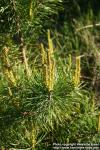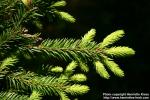Juniper berries, conifer twig syrup.
To: herbs.teleport.com
Subject: re: RE: Herb study
From: Henriette Kress <HeK.hetta.pp.fi>
Date: Wed, 24 Jan 1996 22:32:09 -0100
>Oh, what about using juniper berries in cooking. I've come across recipes and we have juniper bushes in our yard, but I'm always wary if what I've got is the right thing.
Juniper berries are alright, and give meat that wildfood taste. My mom puts Juniper whole twigs when cooking beef roast and tells her guests that it's venison ... the taste really changes that much. Then a twig into a whole gutted salmon before you put it into the oven, gives a great taste too.
Juniper is a conifer, and as all conifers, it contains resins. Resins will temporarily clog up your kidneys, so if you have kidney problems don't use juniper. Ditto if you're pregnant, as your kidneys are under a lot of pressure already. Other folks can tolerate it with no problems, in moderate doses - do use common sense.
And you can make syrup with all those bright green conifer twigs in the beginning of summer. Like Juniper, and Pinus, and Picea, which I have used, and know. I can't say which genera grow elsewhere and if these other genera are toxic, so ask someone who knows plants in your area before just going out to strip needles of all green trees in winter.
From: Henriette Kress <HeK.hetta.pp.fi>
>This sounds interesting. Would one use the syrup for flavoring the same way one would the twigs?
Naaa... you put a spoonful in your tea to get a nice flavor, or put it onto your icecream... you know. Just use your imagination, like me.
Subject: juniper (juniperus communis) footnote from spice index.
From: Carl Wikander <cwikander.foxnet.net>
the berries come from a prickly evergreen shrub it grows muchly in the northern hemisphere.
juniperus largely ignored in kitchens of english speaking countries the scandinavians (like me) add berries to marinades for pickled beef or elk.
add to red wine for pork. also in venison, patés, sauerkraut. crushed berries with salt an garlic for game birds before roasting, add allspice and pepper for beef.
(the green berries take two or three years to ripen turning blue-black)
juniper a coniferous shrub of the cypress family after pollination a pulpy covering forms round the seeds to produce berries, on female bushes.
ripe berries are gathered in the fall and dried at 35 deg. C to stop the essential oil evaporating.
aroma and taste bitter-sweet (gin) hint of pine turpintine with slight burning sensation.
(I even add this to my home made beer)
culinary blends with garlic and with marjoram and rosemary
wines, brandy and marinades, brines, beef, pork, sauces, and my favorite paté and cabbage.
FOLK MEDICINE...described by herbalists as a diuretic and anti-inflammatory...
CAUTION avoid juniper in pregnancy and if you have kidney disorder.
From: Henriette Kress <HeK.hetta.pp.fi>
>ripe berries are gathered in the fall and dried at 35oC to stop the essential oil evaporating.
The easiest way to pick juniper berries? Either by hand (you have to have leather gloves) or with these _really_ nifty berry-picking things we got over here. They're made for either blueberries or lingonberries, but they do _really_ dandily for junipers, too. Either way you should also put a big sheet under the bush you're harvesting to get all the berries that fall off because you shake the bush during picking.
To clean the berries: let them roll over a towel. The needles and other not wanted stuff will stay at the top end of this towel, the berries and creepy-crawlies will come to rest at the bottom end. Then wait for an hour or so to give the creepies a chance to leave (they did not appreciate the treatment they just got and will do their best to get to other parts of the woods). Then collect your berries and dry them.
After you've dried your berries discard _all_ brown ones. And look thru the rest for wormholes (they're there...) and discard those berries too.
Henriette (who has done it, can you tell?)

 From: Henriette Kress <HeK.hetta.pp.fi>
From: Henriette Kress <HeK.hetta.pp.fi>
Conifer twig syrup recipe
You pick the green shoots of Juniperus communis, or Picea abies, or Pinus sylvestris, or Abies alba, or possibly other non-toxic conifers, in the beginning of the growing season (over here that's in the beginning of June). (Actually the shoots aren't really green on the Pinus species, but that doesn't matter - just pick those strangelooking sticks.)
If you wait for another week you can pick a lot more (they do grow), just don't let too many weeks go by - they still have to be soft. Remember to ask the landowner for permission, and if it's a forest where they grow trees for the wood, DON'T pick the top shoot. Actually don't pick the top shoot no matter what. I like my trees straight and with only one top.
3 parts (by weight) fresh green shoots, either of one species only or of as many as you like in a nice mix. The taste will differ a bit but not much.
water to cover them
2 parts (by weight) sugar
Put the shoots into water, boil, let boil until the shoots are yellowish. Doesn't take long. Strain. If you wish you can now add another 3 parts of fresh green shoots to the same water and boil these, until they are yellowish. Strain again. Add sugar, boil on low heat until you have a syrupy consistency. It does tend to burn so stir faithfully - but if you ever have cooked anything with lots of sugar you knew that... and yes, this part takes a fairly long time. But you knew that, too.
Use as a sweet spice, it does give a nice foresty flavor to tea, and it's good on icecream too. I keep mine in the freezer, where it will stay liquid. It crystallizes if kept in the refrigerator for long (nice crystals though).
Abies doesn't grow here but I've done both single and mixed syrups of the others.
Henriette

